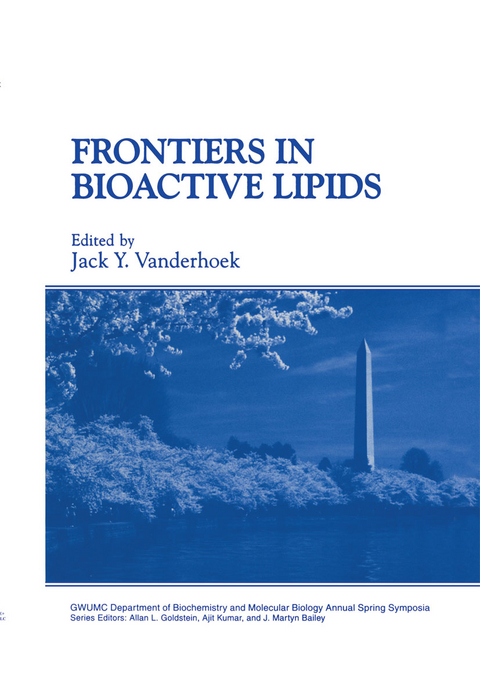
Frontiers in Bioactive Lipids
Springer-Verlag New York Inc.
978-1-4613-7694-1 (ISBN)
Recent advances in our understanding of the fundamental role of bioactive lipids in normal and abnormal physiology was the theme of the XVlth International Spring Sympo- 6-9, 1996 at the George Washington University School sium on Health Sciences held on May of Medicine in Washington, D.C. Over 250 participants shared their latest findings on fundamental mechanisms in lipid metabolism, transport, and signal transduction. Most of the papers presented at the plenary sessions have been collected in this volume, which is divided into seven parts. The focus of Part I is on the new roles that fatty acids and esters play in cellular function. These activities include regulation of gene expression, control of eicosanoid-me- diated responses, and intracellular calcium sequestration. Most biological effects of fatty acids, esters, and phospholipids are transmitted via the interaction of these lipid molecules with specific lipid binding proteins. The chapters in Part II detail the involvement of these in the transport of fatty acids, fatty acyl CoA esters, and phospholipids, and in the proteins modulation of the fatty acid-induced activation of the peroxisome proliferator-activated receptors.
The study of arachidonic acid metabolism continues to be the subject of intense interest and research. A number of studies in Part III deal with the substantial differences between the constitutive prostaglandin H synthase isozyme (PGHS-l or COX-I) and the inducible form PGHS-2 (COX-2) regarding compartmentation, control, and expression.
I—Fatty Acids and Esters.- 1. Molecular Mechanisms Involved in the Adipogenic Action of Fatty Acids.- 2. Acyl Coenzyme A Synthetase and the Transport of Long-Chain Fatty Acids.- 3. The Role of Long Chain Acyl-CoA Esters in the Regulation of Gene Expression and Metabolism in Escherichia coli.- 4. Control of Eicosanoid Response Intensity.- 5. The Role of Fatty Acid within Endoplasmic Reticulum Calcium Pools.- 6. Occurrence of Previously Unknown LPO-Products in Biological Samples.- II—Lipid-Binding Proteins.- 7. Structural and Functional Studies on the Heart Fatty Acid-Binding Protein.- 8. The Role of Intracellular Fatty Acid-Binding Proteins in Cellular Transport of Fatty Acids.- 9. The MRP8/14 Complex and Not the Epidermal Fatty Acid-Binding Protein Is Responsible for the Translocation of Arachidonic Acid in Human Keratinocytes.- 10. Interaction of Fatty Acid-Binding Proteins with the Peroxisome Proliferator-Activated Receptor Alpha. Evidence for FABP Modulation of the Gene Response to Fatty Acid Overload.- 11. The Role of AcylCoA Binding Protein (ACBP) and Long-Chain AcylCoA Esters in Cell Regulation and function.- 12. Phosphatidylinositol Transfer Protein Function in the Yeast Saccharomyces cerevisiae.- III—Eicosanoid Biosynthetic Enzymes.- 13. Compartmentation of Prostaglandin Biosynthetic Enzymes.- 14. Differential Control of Cyclooxygenase Catalysis in PGH Synthase Isoforms: Role of Hydroperoxide Initiator.- 15. Regulation of Expression and the Functional Role of Cyclooxygenase-2.- 16. The Regulation of Prostaglandin E2 Synthesis by Interleukin-1? and Ceramide in Human Fibroblasts: Effects on Cyclooxygenase-1, Cyclooxygenase-2, and Phospholipase A2 Gene Expression.- 17. Regulation of Vascular Smooth Muscle Cell 12-Lipoxygenase by Growth Factors andInflammatory Cytokines.- 18. Manipulations of the Arachidonic Acid Cascade with Lipoxygenase Gene-Inactivated Mice.- 19. Dual Regulatory Role of Cyclooxygenase and Lipoxygenase and Their Products in Cell Survival and Apoptosis.- IV—Eicosanoids and Receptors.- 20. Aspirin Switches Biosynthetic Circuits Triggering Novel Eicosanoids during Cell—Cell Interactions that Are Potent Inhibitors of Neutrophil Migration and Tumor Cell Proliferation.- 21. The Targeting of Leukocytes by 5-Oxo-Eicosanoids.- 22. The Role of Anandamide and Related Fatty Acid Ethanolamides as Endogenous Ligands for the CB1 and CB2 Cannabinoid Receptors.- 23. EP Receptor Subtype-Dependence of Regulation of Immune Cellular Functions by Prostaglandin E2.- 24. Co-Expression of Specific G-Protein ? Subunits Alters the Affinity of Thromboxane A2 Receptors.- V—Sphingolipids.- 25. The Role of Ceramide in the Cellular Stress Response.- 26. Sphingosine-1-Phosphate—A New Lipid Signaling Molecule.- 27. Use of BODIPY™-Labeled Sphinogolipids to Study Membrane Traffic in Animal Cells.- 28. Biological Significance of Tumor Gangliosides: Shedding, Transfer, and Immunosuppression.- VI—Phospholipids.- 29. Lysophosphatidic Acid-Induced Signals in Astrocytes.- 30. Glycerophosphoinositol-4-Phosphate in Intracellular Signalling.- 31. Biosynthesis of Platelet Activating Factor and Related Acetylated Lipids.- 32. Antiproliferative Phospholipid Analogues Act via Inhibition of Phosphatidylcholine Biosynthesis.- VII—Phospholipases/Kinases.- 33. Lipopolysaccharide-, Liposome-Encapsulated MTP-PE- and Dexamethasone-Regulated Prostaglandin Release in Rat Liver Macrophages: Role of Cytosolic Phospholipase A2, and Prostaglandin H Synthase-2.- 34. Regulation of Phospholipase C-? Isoenzymes.- 35. Phospholipase D.- 36.Discrimination between Various Phospholipase D Activities in the Human Neutrophil and Their Relative Involvement in Oxidative Burst.- 37. 12(S)-HETE Primes a Phospholipase D Pathway in Activated Human Blood Mononuclear Cells.- 38. Phospholipase D Activities and Phosphatidylcholine Turnover Are Differentially Related to Expression of Protein Kinase C Isoforms and MARCKS in Control and Transfected Neural Cells.
| Reihe/Serie | Gwumc Department of Biochemistry and Molecular Biology Annual Spring Symposia |
|---|---|
| Zusatzinfo | X, 313 p. |
| Verlagsort | New York, NY |
| Sprache | englisch |
| Maße | 178 x 254 mm |
| Themenwelt | Studium ► 1. Studienabschnitt (Vorklinik) ► Anatomie / Neuroanatomie |
| Naturwissenschaften ► Biologie ► Biochemie | |
| Naturwissenschaften ► Biologie ► Ökologie / Naturschutz | |
| Weitere Fachgebiete ► Land- / Forstwirtschaft / Fischerei | |
| ISBN-10 | 1-4613-7694-7 / 1461376947 |
| ISBN-13 | 978-1-4613-7694-1 / 9781461376941 |
| Zustand | Neuware |
| Haben Sie eine Frage zum Produkt? |
aus dem Bereich


